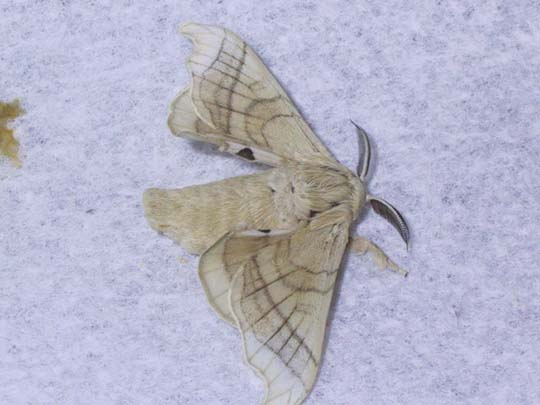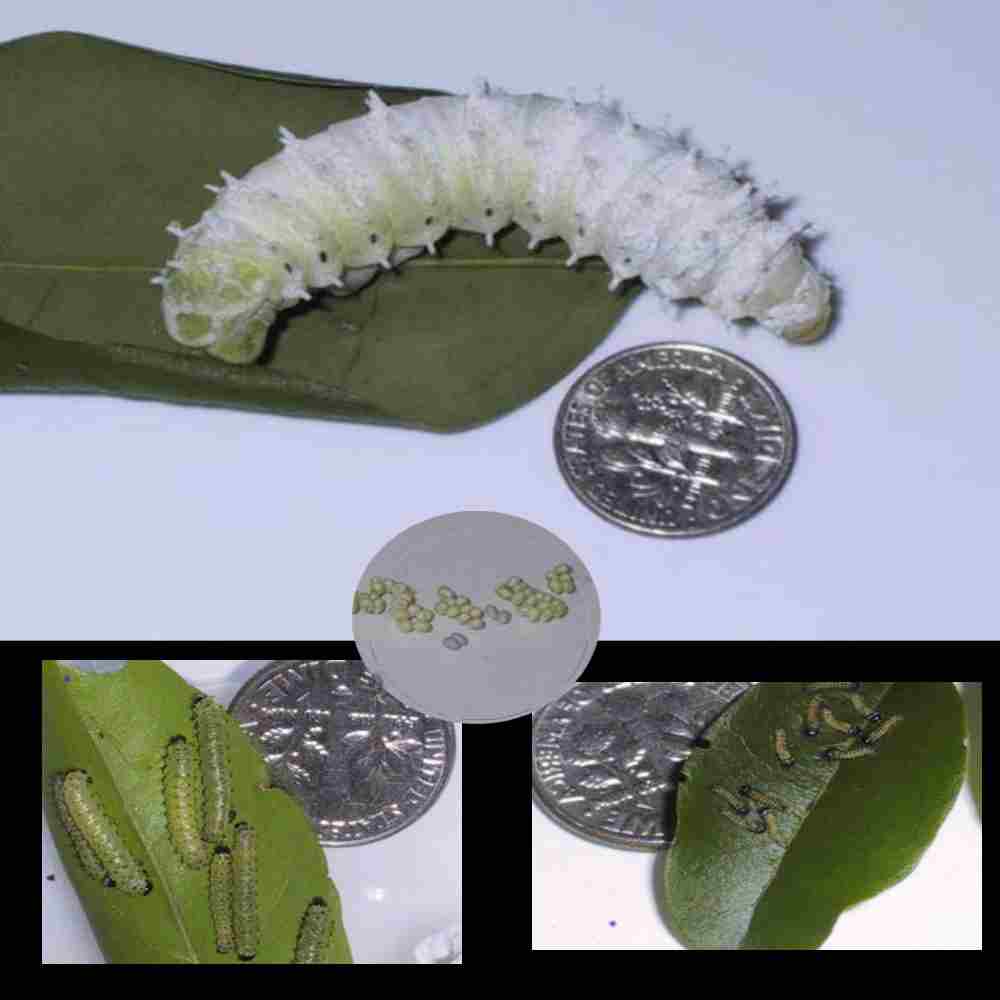Ahimsa (Peace) Silk
Why I Think it Doesn't Add Up
Please note: What follows are my educated opinions, based on extensive reading, consultation with entomologists and sericultural professionals in the US and in India, and my own silk rearing experiences. I am not a vegetarian by any stretch of the imagination, and any statements I make about vegetarianism or veganism are based on reading and discussion with people who follow a vegan or vegetarian lifestyle. Myself, I am content with traditional sericultural practice, where the insects are baked, dried, or boiled in the process of harvesting their silk. I have found a lot of misinformation circulating on the 'net about these special types of silk, some of it deliberate and some of it negligent or unintentional, and I want to put forward my alternative opinions.
Ahimsa Silk, also known as Peace Silk, is processed from cocoons without killing the pupae inside. Many vegetarians and even some vegans have decided that it allows them a way to use silk without sacrificing animal life. In the vast majority of cases, it's more complicated than it appears. I feel that anyone who is using these silk products as part of a vegan lifestyle should carefully consider the process, and see if it really fits with their philosophy.
"Ahimsa," meaning "nonviolence," is a part of Buddhist philosophy, stating that humans should refrain from inflicting suffering on others, including non-human and even non-animal life. There are some Jains (a religious group with many similarities to Buddhists) who take this philosophy so deeply to heart that they avoid killing even the smallest creatures, and provide special houses where insects swept up in household dirt can live out their lives. The expressions of the philosophy, particularly in Western culture, are not usually that extreme - but that gives a good example of a strict interpretation of an Ahimsa path.
There are two main types of Ahimsa Silk, cultivated and "wild" (semi-domesticated).

Cultivated Bombyx mori, male moth
Most cultivated Ahimsa Silk is Bombyx mori. It is raised just like conventional cultivated silk, right up to the point where the cocoons would be stifled, or processed with heat, in order to kill the pupa and keep it from breaking through the cocoon. The Ahimsa cocoons are all allowed to hatch and breed, and the silk is processed from the hatched cocoons. In some cases, the cocoons can be cut open and the pupa tipped out; this avoids the moth soiling the cocoon with urine. The main issue that I have with this style of cultivation being vegetarian-appropriate, is that each fertilized female moth will lay between 200 and 1000 eggs, averaging around 500. In some strains, the eggs will require refrigeration - without refrigeration, the living embryos within the fertilized eggs will wither and die over the course of a month or two. If they are refrigerated, they will hatch upon removal from refrigeration, in which case they have to be fed immediately, or they will die of starvation and dehydration. Either process will require the destruction of approximately 200 - 300 embryos or hatchling silkworm per moth, for any amount that exceeds what is required for the next crop. Instead of killing one pupa for the silk of the cocoon, it kills hundreds of caterpillars. In India, where the vast majority of Ahimsa silk is being raised, most silkworm strains are multivoltine. This means that the silkworms do not undergo refrigeration, and the eggs will hatch approximately two weeks after being laid. The ones that are not fed will die within a day of hatching, from a combination of dessication and starvation. In a batch of, say, 20,000 cocoons, this means that the next generation (if they were all raised) would be two and a half million, and the generation after that, three hundred twelve million. It's just not possible to feed so many. While it may be true that the individual caterpillar that spun the cocoon didn't die inside it, its offspring will have to be ruthlessly culled. Is it considered more virtuous to create conditions of wholesale starvation, to avoid killing the pupa quickly with heat?

Eri silkworm, Samia ricini, life cycle from eggs to caterpillar
There are two other main types of silk worm used for Ahimsa Silk, Samia ricini, the Eri silk moth, and the various Tussah / Tasar moths, such as Antheraea pernyi, the Chinese Tussah moth, Antheraea mylitta, the Indian Tasar moth, and Antheraea assamensis, the Muga moth.
Eri silk is fully domesticated, raised indoors in trays or suspended bundles of leaves, and its life cycle is similar to Bombyx mori. My main issue with the Eri moth is the same as with multivoltine Bombyx strains; the eggs will hatch within two weeks or less, and the majority of them have to starve to death. In actual practice, most Eri cocoons are cut open and the pupa is tipped out; this avoids having the moth soil the cocoon while hatching out from the pupa. Some of the cocoons are allowed to go on and hatch, but they're also a favorite food source for some tribes in India, and the pupae are occasionally used for fertilizer. Check out this site from Nagaland, and look at the photos of Ericulture. Particularly this photo - giant trays of the Eri pupae for sale in the market to eat. They are not flying off into the woods.
Tussah (from China) and Tasar (from India) silk is traditionally raised outdoors on plantations of food trees, which are watched carefully to protect the caterpillars from predation and damage. My problem with Tasar or Tussah silk being Ahimsa Silk, is that it just isn't practical. Reeled silk is the best quality and garners the highest prices; for a farmer to turn all of his prime cocoons into Ahimsa spun silk would be like turning a whole cow into hamburger without butchering out the steaks and roasts. In practice, the cocoons are reeled, and the unreelable portions along with the breeder cocoons are used for spun silk yarns. The specific processing of Tussah / Tasar cocoons varies depending on the particular species and the area where they're raised. Most are simultaneously killed and dried with hot air, although some are kept green (alive) because they store better, and then killed at the time of reeling with steam or boiling water. The idea that Tussah cocoons are plucked from the pristine jungle after the moths have hatched is unfortunately just not supported by facts. I asked a sericulturist in India (Dilip Barooah, of Fabric Plus in the Indian state of Assam, where Tasar, Eri, and Muga are raised) how many Tasar cocoons are allowed to hatch for breeding, and he told me it was approximately one cocoon in ten thousand. It's my understanding that they are on a two-crop cycle, and this probably represents the hatch rate in the second crop, which is the one considered the commercial crop; overall, an average of about 1 cocoon in 200 is required to keep the race alive. So the chances that lumpy hand-spun yarns contain some hatched cocoon silk is decent... but it's probably mostly made from leftovers from cocoons that were killed and reeled. One retailer actually tallies up the percentages of "peace" silk in some yarns - say, half of it is reeling waste and a quarter of it is breeder cocoons, making a yarn 75% "peace"- if that makes you happy, that's fine, but personally, I think it's mathematical sleight-of-hand to justify a high sale price for second-tier yarns. In China, Tussah pupae are also a source of food for many people, and the moths (particularly the male ones) are used in Traditional Chinese Medicine. There are some companies in India making "Ahimsa" silk using cocoons that have hatched for breeding - but nearly every one of that moth's offspring are killed for reeling. Again, I don't see how that makes the hatched cocoons morally superior to the others - they're part of the same agricultural system. It's like only taking milk from female cows that are kept to breed beef cattle.
Many websites will refer to Tussah / Tasar silk as "wildcrafted," and use that as evidence that it is cruelty-free and organic. "Wildcrafted" has a very specific meaning - harvesting from an untended wild environment. Imagine walking out into the woods and picking mushrooms - that's wildcrafting. If you buy acreage of woods and plant mushrooms under each tree and then go back and harvest them a few months later, that's farming. It's very cool, yes, and I think it's a great idea - but if you plant something and then pick it, it's agriculture. "Wild" Tasar and Tussah silks are not wildcrafted, they are farmed. Some of the Indian ones may be allowed quite a bit of range - but their reproduction is controlled, the caterpillars are taken to their food plants, and the cocoons are picked like fruit once the worms are done spinning. They are watched over, similar to how sheep or goats are reared in open pasture; it is frequently work for young children. This video calls it "child labor with a smile." Unfortunately, this "wildcrafted" marketing idea has sold all too well - many people believe it, and even some sites that clearly produce farm-raised, heat-killed silk are using these phrases, like this site from China. "Water reeled" Tussah means that it is processed like Bombyx, reeled in a vat of hot water after killing the pupa. Check out this website on rearing Muga silk (Antheraea assamensis) - see the moths, laying eggs on sticks so that the rearers can carry the sticks to the food trees? See the caterpillars spinning their cocoons in piles of collected brush? Make sure to scroll down past the block of text, to see the big oven.
I think that Ahimsa Silk doesn't really equal non-violence to insects, once you understand the process and do the math. I think that a lot of vegans and vegetarians want to find a way to rationalize using silk - I can certainly understand wanting to wear silk, it's a wonderful fiber, and none of the synthetics even come close. The thing that many people don't do, is look carefully at how the whole system works. If some vegetarians make the determination that it's OK to let the living eggs dry out and die, or ignore the fact that the caterpillars will starve, then that's their business. That's a moral question, and it's not my morality. I'm a bug-baker myself; I make reeled filament silk from the cocoons I raise. I just want to make sure that the peace-silk folks think through the whole process with a clear understanding, especially if they're planning to email me and call me a monster and ask me how I can sleep at night with the blood (or hemolymph, actually - the goo that passes for blood in insects) of so many helpless moths on my hands, etc.
Here are some sites dealing in Ahimsa or Peace Silk. I was kind of torn about listing these, as I've made it really clear that I disagree with their philosophy. But, a lot of people ask me, so here you have some:
http://www.aurorasilk.com/info/peacesilk.shtml - Cheryl Kolander's site, Aurora Silk, is the main source for "Peace Silk" in the US.
http://www.ahimsapeacesilk.com/ - From what I can tell, the silk is being woven in India, although their business phone number goes to Hong Kong.
http://www.meditationbench.com/Ahimsa.html This site is selling Ahimsa Silk Shawls. If you click the link (PDF) on their front page, it takes you to a BEAUTIFUL study about how raising Tasar silk is revitalizing tribal areas in India - unfortunately, the site's organizers must not have read all the way through the PDF, because they're REELING (i.e., killing and unwinding) those cocoons. The PDF isn't about Ahimsa silk at all. Always remember to RTFM. Here is a link to the PDF on its original site.